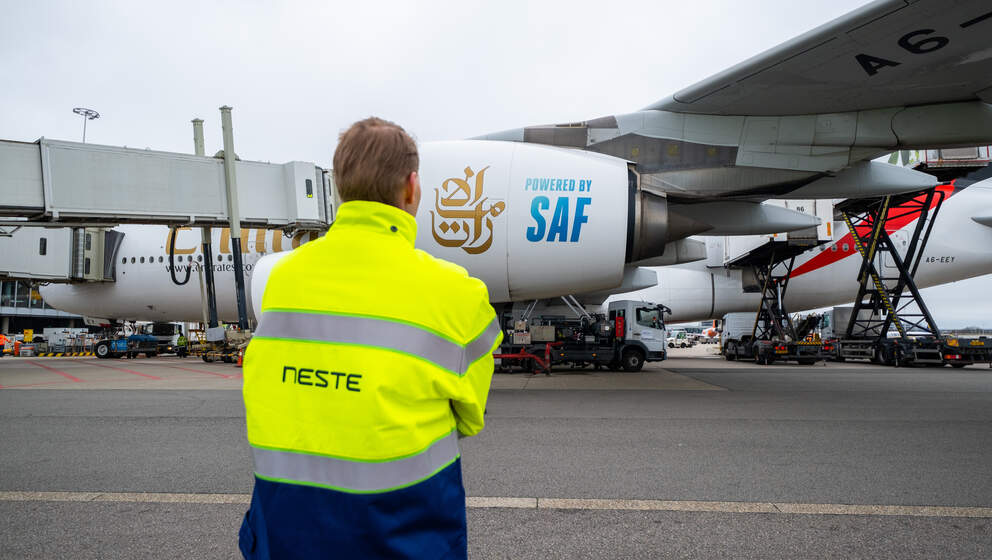What flying could look like in a post-COVID world - A more sustainable future for aviation in Asia Pacific

As we continue to live with prolonged border restrictions, it comes as no surprise there is a pent-up demand for travel here in the Asia Pacific (APAC). Amidst the introduction of vaccines fueling hope for the end of the pandemic, global travel optimism returns.
Faced with the potential surge in air travel when cross-border sparks up again, and the ongoing peak in freight demand, we should continue looking for ways to recover the aviation industry in the Asia Pacific region more sustainably with Singapore as one of the leading countries.

Tackling climate change in the aviation industry
Combating climate change is more important than ever, as the Earth accelerates towards the tipping point of irreversible damage, which scientists believe could now be as soon as 2027.
Prior to the pandemic, IATA predicted over 8.2 billion air travelers by 2037, with more than half of additional passengers coming from the APAC region alone.
Air cargo, an industry that has not typically shown significant year-on-year growth, recorded strong performance this past year, likely due to heightened demand during the pandemic. Industry-wide cargo-ton kilometers (CTKs) increased by 9% in February 2021 as compared to the same month in 2019, with air cargo demand growing by 10.5% in APAC during the same period. With industry reliance on international trade continuing to grow, we can expect a further increase from the air cargo industry.
But with strong growth forecasts in both air travel and air cargo, are we doing enough to curb the industry’s environmental impacts?
Airlines around the world have declared their commitment to international goals of net-zero carbon emission, with major leaders like Singapore Airlines (SIA), Cathay Pacific, Qantas and Air New Zealand joining the movement in APAC. With electric and hydrogen-powered aircraft only expected to be commercially viable by the 2030s and likely to only be available for short and medium haul air traffic, it is imperative that besides exploring other alternative solutions, we should also implement existing available tools to combat the climate crisis before it's too late.
One of those solutions is Sustainable Aviation Fuel (SAF), supported by numerous independent reports as likely to be the single largest way to reduce greenhouse gas (GHG) reductions.
It should not be seen as a stop-gap measure, but rather an already commercially available drop-in solution to help in both the transition to the next generation of aircraft as well as in the long-drawn battle against climate change.

The Sustainable Aviation Fuel industry and its challenges
SAF is identified by IATA as one of the key elements to achieving the aviation industry’s ambitious emissions reduction goals. It is a fuel produced from renewable raw materials, such as used cooking oil, or animal fat from food industry waste, meeting all quality and performance requirements of conventional fossil fuels.
Due to its chemical properties it also burns clean and its use can reduce non-CO2 emissions of aviation, which are estimated to be twice as damaging as carbon emissions in contributing to climate change. Neste MY Sustainable Aviation Fuel™ for example, offers up to 80% reduction in life cycle greenhouse gas emissions (GHG) compared to conventional fossil jet fuel.
However, the journey to industry-wide adoption of SAF comes with a number of challenges. For one, air transport is one of the most impacted industries during the pandemic. As borders remain closed and airlines grounded, the industry faces one of its worst economic downturns in history. While this has forced some players to focus on short-term survival, it should not be an excuse for the industry to step back from long-term sustainable development. We need to strike a balance between economic and sustainability targets.
The importance of governmental support for the adoption of SAF to meet industry climate goals is significant. Mandates, which require a certain share of all jet fuel to be SAF, are an essential tool for governments to encourage the adoption of SAF. Countries in Europe are already developing mandates as part of their regional plans. European Commission published on July 14, 2021 its ‘Fit for 55’ climate package, which includes the ReFuelEU Aviation proposal on the implementation of a European wide SAF mandate by 2025. The APAC region, however, is still catching up to its European peers.
One of the sustainability leaders in APAC is Singapore with its Green Plan 2030, making considerable headway in tackling the carbon-intensive maritime and aviation industries. In aviation, the Green Plan seeks to achieve The International Civil Aviation Organisation (ICAO)’s goals of carbon neutral growth from 2020, and 2% annual fuel efficiency improvement till 2050. To achieve this goal, the Singapore government is currently reviewing study findings on use of sustainable aviation fuels at Changi Airport.
The Government of New Zealand is also proposing to implement a biofuels mandate that would include aviation.
But the government's support should not stop at the mandate. There are already seven approved technological pathways for producing sustainable aviation fuels, and the biofuel industry is continuously innovating and exploring new raw materials to further grow the potential of SAFs.
It is important that the governments in the APAC region and across the globe maintain a feedstock and technology-neutral approach in their policy frameworks. The scale of the climate challenge for aviation requires the use of all available solutions that fulfill the established sustainability and greenhouse gas emission savings criteria.

Looking beyond the horizon
Every stakeholder in the global supply chain and Asia Pacific region - governments, regulators, airlines, logistics service providers, communities, business travellers and private passengers - have a part to play in making the aviation industry more sustainable, only together we can create a healthier planet for our children.
The road to a new normal is paved with many challenges. We need to continue strengthening the collaborations to make the essential changes for the industry. An industrial association in Australia already established the Sustainable Aviation Fuel Alliance of Australia and New Zealand, which aims to create a collaborative environment to advance SAF production, policy, education, and marketing.
Neste as a company also aims to become a global leader in renewable and circular solutions. To achieve this ambition, we have developed ourselves to be the world’s largest producer of sustainable aviation fuel, refined from waste and residues.
But we do not just stop here. We are currently expanding our production capacity in both our Singapore and Rotterdam refineries. Neste’s Singapore Expansion Project is a major undertaking in expanding the company’s production capacity of renewable and circular solutions by up to 1.3 million tons, with up to 1 million tons of additional SAF production capacity expected by 2023.
On top of that, we continue to work with leaders across the aviation industry to further grow the potential of sustainable aviation fuels. One such example includes the in-flight emissions study by Neste, Airbus, Rolls-Royce, and DLR on using 100% SAF on wide-body commercial passenger aircraft. The study seeks to provide new data to support the usage of 100% SAF, without the need to blend with fossil jet fuel, as well as better understand its beneficial impacts on reducing emissions.
Neste is continuously expanding its collaborations and partnerships both globally and regionally to create a more sustainable aviation industry. For example, in 2020, we built our first partnership with All Nippon Airways (ANA) in Japan to reduce their emissions in spite of disruptions caused by the pandemic.
In the air cargo sector, Neste is supplying SAF to DHL Express operating from San Francisco International Airport (SFO), and many other logistical providers.
And in the business sector, in June this year, Neste and Boston Consulting Group (BCG) have signed a new agreement for the purchase of Neste MY Sustainable Aviation Fuel™, to be delivered to airlines SAS and Finnair, covering the volume of all the flights with these carriers taken by BCG employees in the Nordics.
Neste is leading by example: We are compensating for the emissions from our employee business flights through the use of the company’s own sustainable aviation fuel via partnerships. The company has already joined KLM's corporate biofuel program in 2019. Neste has also announced its partnership with Finnair in March 2020, where one of the targets is to reduce Neste employees' own emissions on Finnair flights with the use of sustainable aviation fuel.
We believe, with collective efforts from governments, regulators, aviation leaders, logistics service providers, and business and private travellers, the aviation industry will remain in its pioneer position in technological innovations, and create a more sustainable aviation sector for generations to come.



